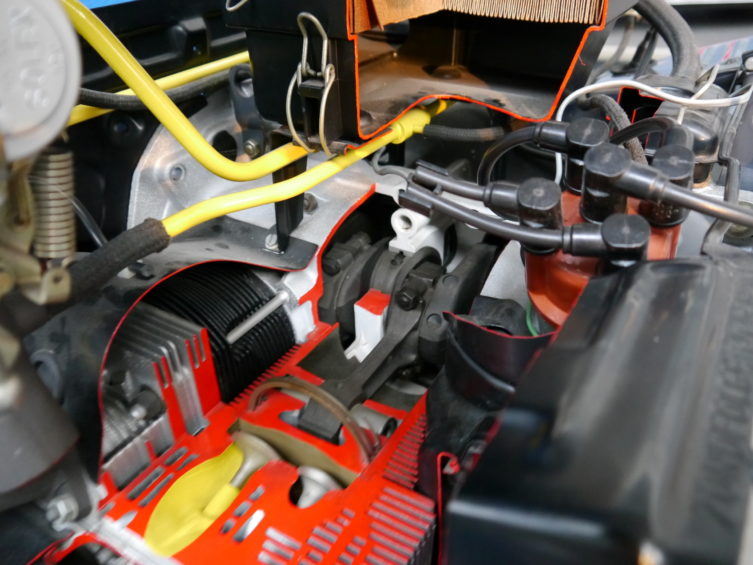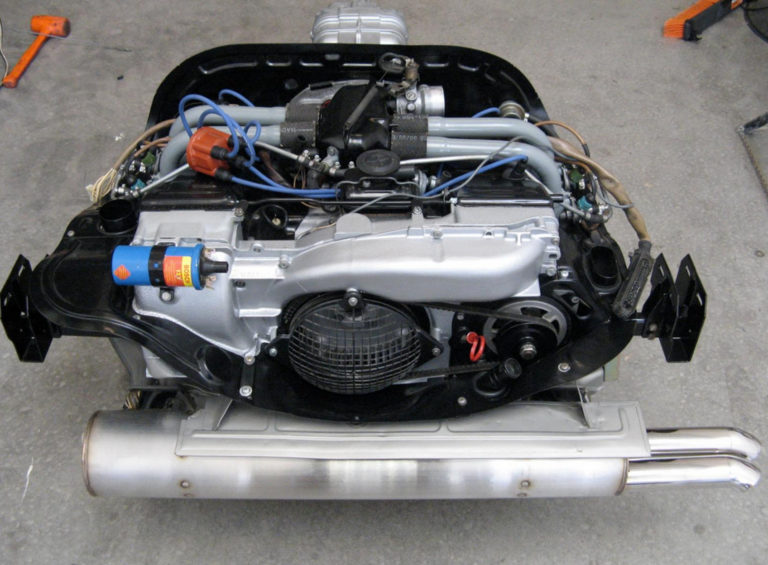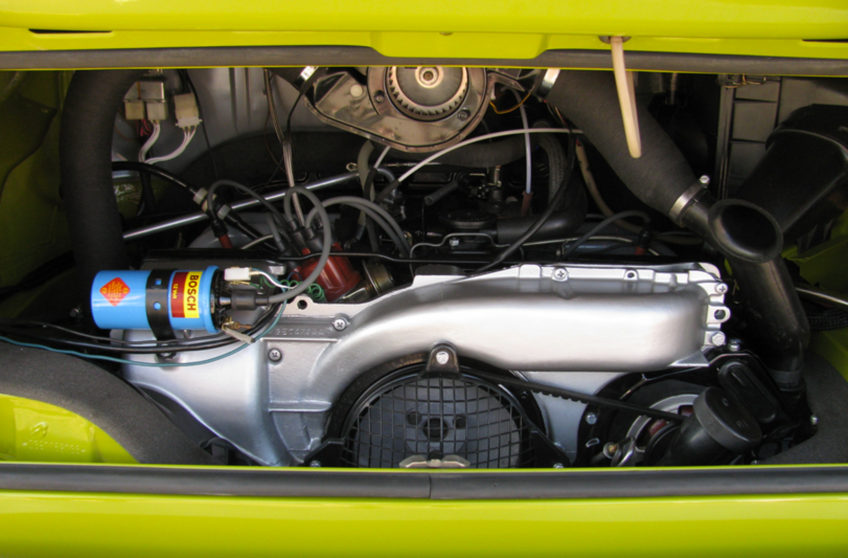The Type 4 engine broke new ground and was VW’s most technically advanced powerplant to date when it made its debut in 1968. Vastly different in both appearance and design to the air-cooled Type 1 unit which we blogged about here, it still impresses today – not least for its silky power delivery. Here’s a short explanation of its main features…
Keen to tap into the lucrative family car market, by the early 1960s VW needed a car with more luggage space to store the family’s chattles, and to this end devised a new, flatter engine that would fit under the floor to provide more boot space. It was a concept that made its debut in the Type 3, but by the end of the decade, with a desire to market a bigger, even more sophisticated car – namely the 411 – Volkswagen needed a completely new engine.

While visually very different to the Beetle powerplant in terms of its cooling shroud, the new 86bhp 1679cc unit was also significantly over square (the pistons and cylinders are much wider than they are long), so it also had a much shorter stroke. The result? A more robust engine with lots of low down torque that was able to cruise at high speeds, while producing less heat – and less stress. In other words, it was ideal for powering a heavier, more refined luxury car. And when installed in the 411 it enabled it to do 0-50mph in 11.5 seconds and reach the heady heights of 90mph.

In 1972 the engine’s twin carb setup was given a shot in the arm courtesy of Bosch D-Jetronic electronically controlled fuel injection which boosted power to 85bhp. With it came a name change to 411LE. That engine was also used in the VW Porsche 914 and also the first 412 when it arrived in August 1972. In the latter application, 0-65mph could be reached in 15 seconds with an accompanying maximum speed of 96mph.
The next big change came towards the end of Type 4 production when capacity grew to 1795cc and fuel management reverted back to a twin carburettor arrangement, accompanied by a change in name from 412LE to LS. Power fell to 68bhp.

When Type 4 production came to an end in 1974, the engine carried on as an option in the Type 2 (as above), with capacity eventually increasing (in around 1976) to 2.0-litres. It was even used in the T25 from 1980 to 1983, albeit feeling somewhat underpowered by this point given the vehicle’s not insignificant weight.
Of course the Type 4 engine went through various stages of evolution throughout its lifespan, getting hydraulic lifters from around 1978 (there will be a sticker telling you not to make any adjustment) and electronic ignition from 1979. Needless to say, very little, if anything, can be swapped between the Beetle engine; everything from the tinware to the exhaust is different. From a power delivery and performance perspective, the rugged Type 4 engine has for a long time been a favourite with tuners, although it’s a tight squeeze to say the least in the back of the Beetle’s engine compartment with much fabrication needed to accommodate its extra width. None the less, a properly set up Type 4 with beefier carbs is a formidable bit of kit. And the good news is you can still get all the necessary parts here to keep it in rude health.
Of course we’ve only just scratched the surface regarding the major differences here, so if there’s any peculiarities of the Type 4 engine you would like to share, please let us know…
Ian
The opinions expressed here are the personal opinions of the author and do not necessarily represent the views and opinions of VW Heritag


Great Information! Thank You.
great info and great piccies very helpful. tnx steve
Hi , really interesting read on the t 4 flat fuel injection . I have a rare I think 78 Berlin with exactly this and it runs like a rolls Royce compared to my splits !! Difficult seeing fuel injector lines though . Any suggestions who would be able to service this vehicle in Brighton ?? So far it’s been fab and I change the main fuel lines and do a mini service , but a thorough service could be a benefit !! See you all on Thursday at heretics . Neil
Hi Neil, Heretics isn’t this week – it’s on the 17th August this month.
How compact or short was the Type 4 engine compared to the preceding Type 1 and Type 3 units? – https://i.kinja-img.com/gawker-media/image/upload/rjwnf2bysmles90ikpfi.png
Am asking since have read two somewhat outlandish Jalopnik articles on the Beetle. The first looks into the possibly of an updated Beetle using the compact Type 3 engine to free up more rear boot space and thus potentially justify a rear-opening hatchback of some form. – https://jalopnik.com/i-have-some-advice-for-volkswagen-only-50-years-too-lat-1818581916
The second is regarding the thoroughly updated 1970s 2/4-door Super Beetle design concept by Herbert Schäfer, which had it been made (in better circumstances of course) would appear likely to have used the Type 4 engine. – https://jalopnik.com/the-forgotten-beetle-four-door-sedan-that-volkswagen-ne-1792130876
Had both entered production, am interested in knowing whether the latter could have carried over some form of rear-hatchback provided the Type 4 engine was similar to the Type 3 in terms of compactness?
Also did Volkswagen ever look at a de-bored versions of the Type 4 engine (e.g. 87-88mm) to effectively replace both the 1600cc Type 1 and 3 engines?
Some interesting links there Yohan, thanks for sharing with us.
Interesting comments, however, in 1971, while living in Belgium, I purchased a 411E wagon (3 speed automatic) with American specifications but the European engine. It was confirmed to reach around 135 mph (which I only did a few times) and possibly above. Each time that I had it tuned (about every 8000 miles), I would carefully explain that the engine must be turned to European specs; one dealer who ignored my comments nearly caused my wife to be killed when she pulled out from the dealership and the vehicle stalled in front of an on-coming semi. My “explanation” to him shortly thereafter was sufficient that every visit to him thereafter was very satisfactory.
hi there,
nice article.
i have one of these engines in my bay 1973 T2.
the carbs are playing up and i am getting a lot of mixed advice.
> replace with a webber conversion.
> rebuild the carbs.
> replace the carbs.
the current carbs are solex carbs, one on each side. the mechanic i have looking at it at the moment, is a little slow, and i am looking for someone who specialises a more in the VW, this guy does classic cars but i am not convinced that he is a vw lover or enthusiast.
please, if you have some deffinative advice, anyone, i would really appreciate it.
thanks, M
Hi.
Very informative article.
Question: from a guy assembling a Type 4 engine (on YouTube), his was with solid lifters (and he echoed that the 2.0ltr ones had hydraulic lifters.
How would I be able to tell what I have on my motor? (I am in the process of purchasing one of those type of motors).
Also, are the parts within the various engine sizes of the type 4 interchangeable as is with the type 1 engine?
Also, what exact carburetor size (type) came with the twin carb version of engine? What carb is that I see with the centrally mounted design?
Thanks
KKV270
@Patrick In the US at least, the hydraulic lifters were on engines with the GE prefix. GD and all previous type 4 engines were solid. This may have changed with a previous owner, though. Hydraulic takes a slightly different camshaft grind, duration or something. If the center of the pushrod is magnetic, then they are hydraulic. If only the tips of the pushrods are magnetic, they are solid. Hydraulic lifters have a circlip in the top of them, if you peer into the hole vacated by the pushrod with a flashlight.
How to find out where is the piston # 1 on my type 4 Engine on my bus 1975
Thanks Alfonso
im no mechanic but if you find 2/3/4 your getting warm (good
luck)
I have seen this engines posted that they have been built to a 2336 cc capacity and fitted into a 914 porsche is this done by fitting oversized pistons and barrels.
Does the engine then have to have the crank and bottom end bearings strengthen.
How hard will be to swap from T1 to T4.???
Transmisdion will fit straigh without modifications?
im in USA.
Hi Washington, yes it will fit into stock transmission. You need to check joe Cali type VI upright conversion.
You will have to use the 1.7 flywheel, and there are kits available for the clutch.
6V transmission needs some work with a aluminiums grinder.
Hello ….. I thought that the 1974 412 LS 1800cc twin 40mm Solex carb engine was the most powerful type 4 motor the the VW factory ever produced …… 85 bhp ……… is this true ??
Cheers Richard Bell
WoW I just learn that my 78 VW bus has the same 914 Porsche engine!
I can now brag that I drive a Porsche van that can carry 8- passengers (-;
Have 1700 bus The junk yard Dog .
Hi, I just swapped out my type1 1600 twin port for a 2 litre type 4 that I rebuilt over the winter coupled to a a rebuilt long legged gear box. Chuffing heck the difference is amazing!!! A lot faster, 80 mph easily achieved with a mid 60s cruising speed for 1300 miles round France, loads quieter as well. If you do this make sure you fit a brake servo ( I fitted a remote dual) as your gonna need some more stopping power!! MPG is down, around 24 MPG at 60 mph, but balancing and tuning the twin solexs was fairly easy using the power of google
Wow.
I did the same…dropped the 1600cc pancake off my Transporter and fit a 2000cc type 4… however, I’m yet to experience the full potential of that engine. I’m still learning the engine- tuning up here-there… I know I’ll have the same to share soon.
Looks like I might be looking at a rebuild for the 3.0 in my ’83 911SC, which I’ve been told could cost upwards of $20K. Exploring some options here, would a Type 4 VW engine bolt up to the Porsche 915 transmission? Is the Type 4 the correct engine to be looking at as a replacement in my 911? Thanks
Hi Robert,
You could do that – of course, bear in mind the power deficit.
There is a video of such a conversion here. https://www.youtube.com/watch?v=qDcE0KXj-5w
Alternatively, you could consider a Subaru swap, either for an NA or a Turbo motor, to give something more similar (or better) in performance to the old engine.
Best of luck.
Andy
Nice article . Can you tell me How easy, and what parts are needed to take a 1700 type 4 up to 1800?
Got here late in this post but i just bought a truck load of VW stuff from a friend. He had a shed that was packed. There were 3 engines in there for a bonus. I know nothing about type 4 motors but this one has been in the shed since 95, and when i grabbed hold of the flywheel it would turn over , so at least its not froze up. Complete even down to the original 2 carburators. Heading back to florida with my haul in the morning. Oh, i checked the numbers. It is a 74 1700 80HP version. Anybody interested?
Does anyone at all know if a type 4 engine can be put into a Porsche Boxster??
I have read every article I can find and never find an answer to this big question. I have been told that the Type 4 2.0L engine installed in the 914 Porsche is actually different from the VW cars. I’ve been told they were actually built by Porsche with bigger valves, a more aggressive cam, a stronger engine case and other things. Other people say no, that it’s totally VW, built by VW and identical to the engines in the VW’s, such as the 411. Does anyone have a clue what the real story is?